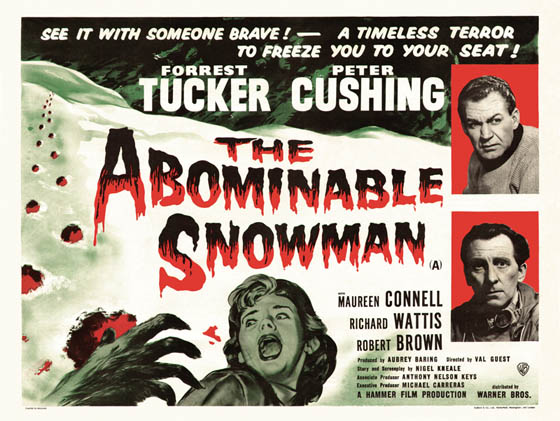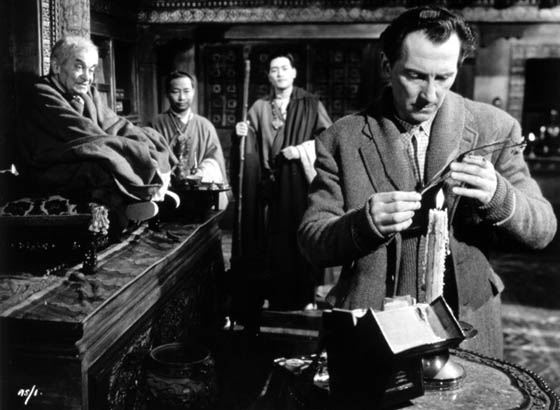 1957 was a landmark year for Hammer Films: The Curse of Frankenstein was released that spring, a full-color adaptation of the Mary Shelley tale with Peter Cushing as the doctor, Christopher Lee as his monster, gooey brains, bright red blood, and a proud “X” certificate. It was full speed ahead into the new world; Dracula (1958), The Mummy (1959), and more than a decade’s worth of sequels would follow. Often overlooked in this explosion of classic horror is The Abominable Snowman, released in the late summer of ’57, following hot on the heels of both The Curse of Frankenstein and Quatermass 2. It could be seen as a transitional film for the studio. The black-and-white, the evolution theme, and the script from Quatermass creator Nigel Kneale, all seem to grant it a kinship to Hammer’s 50’s SF thrillers initiated by The Quatermass Xperiment (1955). But it is a monster movie, after all, and Peter Cushing is the star. Transitional or not, this is classic Hammer horror, and one of their best films of the decade.
1957 was a landmark year for Hammer Films: The Curse of Frankenstein was released that spring, a full-color adaptation of the Mary Shelley tale with Peter Cushing as the doctor, Christopher Lee as his monster, gooey brains, bright red blood, and a proud “X” certificate. It was full speed ahead into the new world; Dracula (1958), The Mummy (1959), and more than a decade’s worth of sequels would follow. Often overlooked in this explosion of classic horror is The Abominable Snowman, released in the late summer of ’57, following hot on the heels of both The Curse of Frankenstein and Quatermass 2. It could be seen as a transitional film for the studio. The black-and-white, the evolution theme, and the script from Quatermass creator Nigel Kneale, all seem to grant it a kinship to Hammer’s 50’s SF thrillers initiated by The Quatermass Xperiment (1955). But it is a monster movie, after all, and Peter Cushing is the star. Transitional or not, this is classic Hammer horror, and one of their best films of the decade.
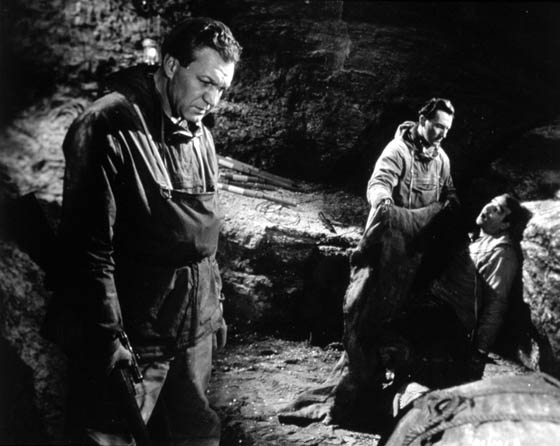
Tom Friend (Forrest Tucker) and John Rollason (Peter Cushing) cope with the aftermath of a Yeti's rampage.
Cushing is top-billed, but he shares the space with an American, Forrest Tucker, who had starred in countless B-westerns, and would shortly appear in Auntie Mame (1958) as well as another British SF movie, The Crawling Eye (1958). It was standard practice in this period for Hammer to recruit an American actor to help sell their product to the States, though one doubts there would be many American boys desperate to see a movie called The Abominable Snowman just because Forrest Tucker was in it. No, the monster is the allure here, and director Val Guest (The Quatermass Xperiment) smartly uses anticipation of the titular Yeti to his advantage, keeping the creature off-screen as much as possible while continually hinting at its presence. In the meantime, it’s Cushing who dominates. He’s the hero, Tucker the antagonist (though he’s named, ironically, Tom Friend); and you root for the British botanist while scowling and shaking your fist at the bloodthirsty, thick-headed American. Cushing plays John Rollason, and as the film opens, he’s trying to negotiate with a Tibetan Lhama (Arnold Marle) for permission to explore the Himalayan cliffs around the monastery, ostensibly to study the plant life beneath the snows. But there are suggestions that the Lhama can read minds, and soon enough he susses out Rollason’s true motive: he will be meeting up with the notorious American hunter Friend to track down the mythical Yeti. The Lhama gives his permission, but warns him that he might not like what he finds. So Rollason departs into the treacherous slopes with Friend and a small team of climbers, leaving behind his stubborn wife Helen (a wonderfully headstrong Maureen Connell) and their stuffy teammate Fox (the ubiquitous British actor Richard Wattis).
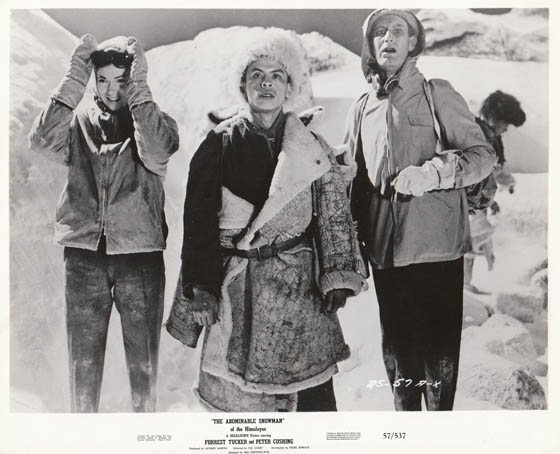
Publicity still for the American release: Maureen Connell (left), Richard Wattis (right), and their Sherpa guide search for John Rollason's lost party.
Once deep in the wilds of the Himalayas, Tom Friend proves to be unworthy of his name: his real intention, he reveals, is to capture one of the creatures alive; along with a trapper named Ed Shelley (Robert Brown, The Steel Bayonet), he’s working for a commercial venture which intends to turn a profit on the discovery of the Abominable Snowman (shades of King Kong‘s Carl Denham). Rollason is outraged – he only wanted to study the creature in its habitat – but he depends upon their skills to find the Yeti, and so they form an uneasy truce. One member of their party, McNee (Michael Brill), begins to psychologically unravel under the keening noises heard in the distance (and which can only belong to Yeti). When he glimpses a giant, hairy claw pushing through his tent and groping about, handling one of their rifles, he is further undone. But soon enough Shelley actually manages to shoot one of the creatures dead – much to Friend’s consternation, since he’d rather have a live specimen. We don’t see the Yeti’s body directly; Val Guest plays coy. You see its colossal shape beneath a canvas, and a hairy arm extending out of it. When the trackers expose the face, we see only their expressions, and listen to their awestruck description of it: not human, but not animal…wise-looking and strangely sad. As they camp out with the body of the creature, Friend insists they use it as bait to bring in another – and this one he intends to capture alive. As you’d expect, disaster follows.
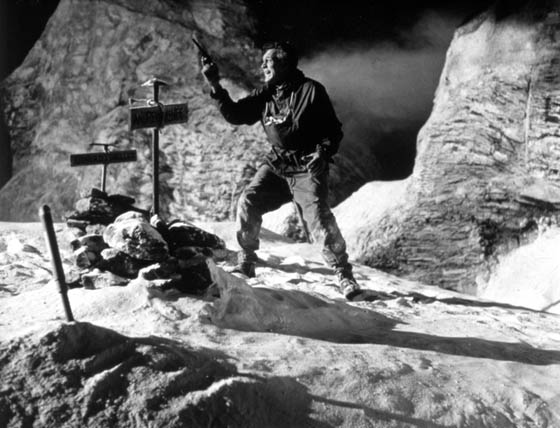
Amidst the freshly-dug graves of his teammates, Tom Friend confronts the monster in this publicity still.
What separates The Abominable Snowman from its Hammer brethren is the stunning location footage of the climbers navigating steep and snowy mountains, captured by Guest in the French Pyrenees. Though we’re always aware that our actors are on sets (however great-looking those sets are), the integration of the location shots is skillfully done, and it’s easy to suspend your disbelief and get lost in the mountains with Cushing, Tucker, and company. The script by Kneale, adapted from his teleplay The Creature, strikes sparks with every line of dialogue, and remains compelling to the very end, and the Yeti’s ultimate, eerie reveal; Kneale really was the Stephen Moffat of his day. It’s also easy to admire that, for a 50’s monster movie, this one does not take the position that it’s best to kill the monster. The Yetis represent some evolutionary offshoot, perhaps a superior one to the human race; to murder them, in this context, is presented as the moral equivalent of setting off an atom bomb: somehow, we’re dooming our race. And they’re psychic, did I mention? Just as the High Lhama practices low-level psychic powers when he’s in the presence of Cushing, and (it’s suggested) astral projection, the Yetis have an even more sophisticated psychic ability. Perhaps it’s their ability to read a man’s mind and soul that ultimately saves Rollason from their wrath. This is first-rate Hammer, with another grand, evocative score by James Bernard. The new bare-bones, budget DVD from Icon in the UK is serviceable; it’s an anamorphic transfer, but lacks detail, and doesn’t seem as film-like. A Blu-Ray would be welcome.
